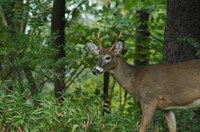“The talk of the streets and taverns has all been about the so-called death curse: a wasting disease… Victims grow thinner and weaker each day, slowly but steadily sliding toward the death they once denied.
When they finally succumb, they can’t be raised—and neither can anyone else, regardless of whether they’ve ever received that miracle in the past. Temples and scholars of divine magic are at a loss to explain a curse that has affected the entire region, and possibly the entire world.”
If you’re a Dungeons & Dragons fan, you may recognize this story line known as the Tomb of Annihilation. If you’re a deer manager, you may recognize this story line known as chronic wasting disease (CWD).
For those who are not Dungeons & Dragons fans, it is a fantasy role-playing game created in the 70s. It has a bit of a cult following. Catch an episode of The Big Bang Theory and you’ll get a feel for the D&D crowd.
Unfortunately, wildlife disease is not a game, especially CWD. For those not familiar with CWD, it’s an always-fatal infectious disease of cervids (deer, elk, moose, caribou, etc).
The CWD story line is frightening enough but the addition of an annual life event of the white-tailed deer makes it more of a nail bitter. I’m talking about the other D & D – dispersal & disease and what it means for deer and deer management. 
Fall is a major dispersal period for yearlings – bucks to be more specific. Thousands of yearling bucks are setting out for places unknown to establish a new home range. In Pennsylvania, about 75% of yearling males disperse with more than half of them dispersing in fall. About 18% of yearling females disperse each year, but they disperse in the spring.
To put this in perspective, nearly half of ALL yearlings leave their natal range!
The 2 most prominent and supported theories for how dispersal occurs are based on social interactions. In the spring, it is the result of maternal aggression toward her yearling male and female fawns. In the fall, dispersal of males is a result of competition from other males in the area.
I recently returned from a trip to Canada. While there, I picked up a fridge magnet for my mom and a rhinovirus for me. Now I can spread the rhino-love to all who contact me here in America.
My runny nose and sore lymph nodes are inconvenient and highly annoying but I’ll live. Traveling for a deer with CWD is not as benign. Dispersal and disease are a wildlife manager’s worse nightmare…like the Tomb of Annihilation.
Pennsylvania currently has 2 Disease Management Areas (DMAs). Thousands of yearlings have packed their bags and have hit the road. If they are CWD positive, they are getting ready to potentially spread this disease to a brand new area.
 But what can be done to stop this? Is there a way to stop yearlings from dispersing and slay the dragon of CWD?
But what can be done to stop this? Is there a way to stop yearlings from dispersing and slay the dragon of CWD?
The only way we could truly stop a yearling from dispersing is to remove him or her as a fawn. But we can’t remove all the fawns.
Can we at least reduce the number of dispersing deer?
Plan B – what if there were fewer deer? It would remove some of those would-be dispersers. Would this affect dispersal of the remaining yearlings?
With all the research done in Pennsylvania, here’s the likely outcome of fewer deer on the landscape regarding dispersal:
- The lower the deer density the lower the dispersal rate for juvenile female deer (Lutz et al. 2015, J. Mammalogy)
- Deer density seems to have no effect on dispersal rates of juvenile male deer BUT with lower deer densities there will be fewer juveniles to disperse (Long et al. 2005, J Mammalogy)
- Deer density has no effect on adult deer because we have never documented dispersal in an adult male or female deer (Long et al. 2008 Behav Ecol, Lutz et al. 2016 J Wildl Mgt)
Let’s not forget that deer are social animals. To reduce populations means removing antlerless deer most of which are female. What happens to movement patterns when a matriarchal female is removed? Without her to lead the way, will the rest of the group wonder about?
Thankfully, we have research on that too. When targeted removals took place in New Jersey, females had larger home ranges as they sought new social groups after the disruption. However, they didn’t shift their core home range by more than 400 meters. And there was no dispersal.
In Illinois after targeted removals, juveniles shifted their home range space use but this area overlapped more than 50% with their original home range. Adult females saw no change in home range at all. Again, there was no dispersal from the area.
So while we cannot stop yearlings from escaping the dungeon (dispersing) perhaps we can slow the dragon (CWD) that is marching across the landscape.
This game of D&D is no fun.
Wildlife Biologist

If you would like to receive email alerts of new blog posts, subscribe here.
And Follow us on Twitter @WTDresearch

